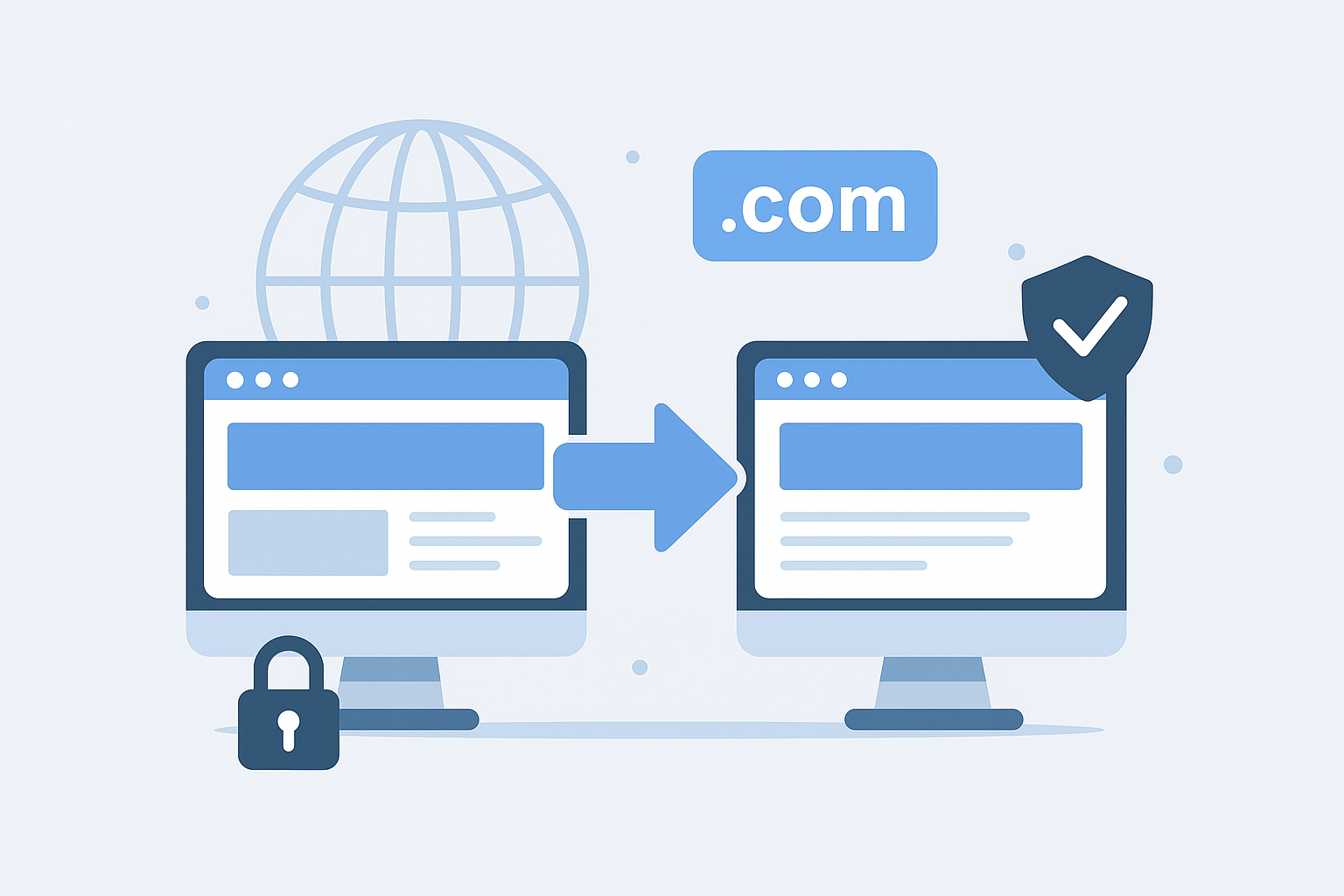Introduction to Website and Domain Migration
In today’s fast-paced digital environment, website and domain migration has become a critical process for businesses looking to upgrade, rebrand, or optimize their online presence. This process involves transferring an existing website to a new hosting platform, domain name, or both, while ensuring minimal downtime and no data loss. FixHackedSite understands the challenges associated with this technical transformation and provides expert solutions to make migration smooth, secure, and efficient. Unlike a simple redesign, a migration involves delicate steps that can affect search engine rankings, site performance, and even customer trust if not executed correctly. Whether it’s moving from one content management system (CMS) to another, upgrading to a faster hosting environment, or changing your domain name for branding purposes, every stage must be handled with precision. In 2025, businesses face increasing pressure to provide faster load times, stronger security, and improved mobile experiences. Migration is often the key to achieving these improvements. However, without the right strategy, you risk broken links, SEO drops, or functionality issues. This comprehensive guide will take you through each stage of website and domain migration, from planning and preparation to execution and post-launch optimization. By the end, you’ll understand why a well-planned migration is not just a technical task but a strategic business move that can elevate your brand’s credibility and performance in the digital marketplace.
Understanding the Importance of Website Migration
A website migration is far more than simply moving files from one location to another. It is a strategic process that can significantly impact a company’s online success. The main reason for migration often includes upgrading to better hosting, improving site speed, enhancing user experience, strengthening security, or rebranding under a new domain name. In today’s digital world, customers expect seamless experiences, and even minor downtime or broken elements can result in lost sales and reduced trust. Migration allows businesses to adapt to modern technologies and user behaviors, such as mobile-first design and faster load times. However, without proper planning, a migration can harm search engine rankings, disrupt customer access, and cause technical issues. This is why FixHackedSite emphasizes a structured approach. Understanding the importance of website migration means recognizing it as a growth opportunity rather than a risk. It’s a chance to realign your online presence with your brand’s evolving identity, upgrade outdated systems, and integrate new functionalities. In essence, website migration is a digital rebirth that, when handled professionally, ensures your site not only survives the change but emerges stronger, faster, and more aligned with your business goals. By investing time in understanding the process, you safeguard your investment and position your brand for long-term success.
Importance of SEO During Migration
When planning a website or domain migration, many businesses focus primarily on the design refresh, technical upgrades, or improved hosting performance. While these elements are important, one of the most overlooked yet critical factors is SEO during migration. Search Engine Optimization isn’t just an afterthought — it’s the foundation that ensures your new site retains its existing rankings, traffic, and authority in search engines. Without a structured SEO migration plan, you risk losing months or even years of organic growth in just a few days.
SEO during migration involves several strategic steps: properly setting up 301 redirects, creating a detailed URL mapping file, ensuring your XML sitemap is updated and submitted, retaining important on-page elements like title tags and meta descriptions, and making sure that internal linking structures remain intact. Search engines rely heavily on signals of continuity to understand that your website hasn’t disappeared, but rather moved to a new location. If these signals are missing or misconfigured, your site may experience dramatic drops in rankings, which can take months to recover.
Moreover, migration is an opportunity to fix existing SEO issues — outdated content, poor mobile optimization, slow page speed, or broken links. By addressing these during the move, you not only preserve your current performance but also set the stage for improved results. In short, making SEO during migration a central part of your strategy is the best way to ensure a smooth transition that protects both your traffic and your brand’s online presence.
Reasons Businesses Need Domain Migration
Domain migration is often triggered by strategic business decisions, and understanding these reasons helps determine the right time for action. One common motivation is rebranding — when a company changes its name to better align with evolving business goals, products, or markets. Another reason is geographical targeting, where a business adopts a country-specific domain extension (such as .co.uk or .com.au) to connect better with local customers. Security upgrades also play a role; older domains may be associated with past breaches or spam activity, prompting companies to start fresh with a new domain. Additionally, SEO strategies sometimes require a shift to keyword-rich domains that improve search rankings. Mergers and acquisitions often lead to consolidation under a single domain to unify brand identity. FixHackedSite advises that while domain migration can bring significant advantages, it also carries risks like losing existing search engine visibility or customer recognition if not executed properly. Businesses must weigh the benefits — such as increased brand recognition, improved targeting, and better market positioning — against the potential short-term disruptions. When handled with the right expertise, domain migration becomes a powerful tool for enhancing online presence, strengthening brand authority, and positioning a business for future growth in competitive markets.
Optimizing SEO During Migration
SEO during migration is a critical step to ensure your website maintains its search engine rankings and visibility while transitioning to a new domain or platform. Without a clear strategy, you risk losing valuable organic traffic, backlinks, and brand trust. The process begins with a detailed SEO audit to understand your current keyword rankings, traffic sources, and high-value content pages. By identifying these assets early, you can create a tailored plan that protects and even improves your search performance during the migration.
One of the most important aspects of SEO during migration is implementing proper 301 redirects from old URLs to their exact new counterparts. This preserves link equity and ensures users and search engines find the right pages. Additionally, update your XML sitemap, robots.txt file, and internal links to reflect the new site structure. It’s also crucial to monitor your site’s crawl errors through Google Search Console during the transition.
Furthermore, keep your on-page SEO elements — such as meta titles, descriptions, headers, and alt text — consistent unless you’re intentionally optimizing them for better results. You should also maintain a regular publishing schedule before and after migration to signal to search engines that your website remains active and authoritative.
By carefully planning and executing SEO during migration, you can avoid common pitfalls, safeguard your online presence, and even create opportunities for higher rankings and increased traffic once the move is complete.
Pre-Migration Planning for Success
A successful website and domain migration begins with meticulous pre-migration planning. This phase is crucial because it sets the foundation for a smooth transition without unexpected setbacks. Businesses must begin by defining clear migration goals, such as improving site performance, changing branding, or enhancing security. Creating a detailed checklist ensures that every aspect — from data backup to SEO preservation — is accounted for. FixHackedSite strongly recommends conducting a full site audit before starting. This includes reviewing existing content, identifying outdated or low-performing pages, and noting all current URLs for accurate redirection later. Another important step is selecting the right hosting provider and ensuring it supports your technical requirements, such as CMS compatibility, bandwidth capacity, and security features. Timing is also critical; migration should be scheduled during periods of low traffic to minimize customer disruption. Teams must be prepared with rollback plans in case of unexpected issues, ensuring the ability to revert to the old system quickly. Proper pre-migration planning reduces risks like broken links, lost data, or SEO penalties, and ensures the project stays within budget and on schedule. By investing time in preparation, you create a roadmap for success that guarantees your site emerges from migration stronger and more competitive.
SEO Considerations During Website Migration
When planning a website migration, SEO should be at the top of the priority list. A poorly managed migration can lead to significant drops in organic traffic, search engine rankings, and overall visibility. Search engines rely heavily on URL structures, meta tags, and internal links to index and rank your site correctly. Any disruption to these elements can confuse search algorithms, causing a decline in rankings. FixHackedSite ensures that before migration, a complete mapping of existing URLs is done so that each old URL has a corresponding new URL via 301 redirects. This prevents the dreaded “404 Not Found” errors, which negatively impact both user experience and SEO performance. Additionally, metadata such as page titles, descriptions, and header tags must be preserved or strategically updated to match new site goals.
Another key SEO consideration is maintaining keyword optimization throughout the migration process. Your current keyword rankings represent valuable digital real estate, and losing them can mean a substantial drop in traffic. To safeguard these, you should conduct an SEO audit, identifying your top-performing pages and ensuring they are given priority during migration. Search engines also value consistent uptime, so any downtime should be minimal. After migration, submit the updated sitemap to Google Search Console and Bing Webmaster Tools for faster indexing. By treating SEO as an essential part of the migration process rather than an afterthought, businesses can not only preserve their rankings but also potentially improve them. This proactive approach ensures that the new site launches with its search engine performance intact — or even stronger than before.
Choosing the Right Hosting Provider for Migration
 Selecting the right hosting provider is a critical step in ensuring a smooth migration. A host acts as the foundation for your website, impacting everything from site speed to uptime reliability and security. FixHackedSite recommends evaluating potential hosting providers based on their performance benchmarks, scalability options, customer support, and security features. For businesses upgrading their websites, it’s essential to choose a host that can handle increased traffic loads and offers features like SSD storage, Content Delivery Networks (CDNs), and robust DDoS protection. Reliable hosting not only ensures faster loading times but also minimizes downtime during the migration process — a factor that significantly influences SEO and user trust.
Selecting the right hosting provider is a critical step in ensuring a smooth migration. A host acts as the foundation for your website, impacting everything from site speed to uptime reliability and security. FixHackedSite recommends evaluating potential hosting providers based on their performance benchmarks, scalability options, customer support, and security features. For businesses upgrading their websites, it’s essential to choose a host that can handle increased traffic loads and offers features like SSD storage, Content Delivery Networks (CDNs), and robust DDoS protection. Reliable hosting not only ensures faster loading times but also minimizes downtime during the migration process — a factor that significantly influences SEO and user trust.
Equally important is choosing a host that provides expert migration assistance. Some providers offer free or managed migration services, handling the transfer of files, databases, and email accounts with minimal disruption. This can save your business considerable time and reduce technical risks. Also, consider backup and recovery solutions — your hosting provider should automatically create backups so that you can quickly restore your site if anything goes wrong. Pricing, while important, should not be the sole deciding factor; a cheaper host that compromises performance or security will ultimately cost more in lost business and maintenance. A carefully chosen hosting provider becomes a long-term partner in your business’s online success, ensuring that the migration process is not only seamless but also sets the stage for future growth and stability.
Creating a Migration Timeline and Checklist
A well-structured migration timeline and checklist are essential to keeping the website and domain migration process organized and efficient. Without a proper plan, critical steps can be overlooked, leading to technical issues, SEO losses, or even complete site downtime. FixHackedSite recommends breaking the migration down into specific phases: planning, testing, execution, and post-launch monitoring. Each phase should have clearly defined tasks and deadlines. For example, during the planning phase, you would finalize your hosting provider, back up your existing site, and audit all URLs.The testing phase might involve setting up a staging site to ensure all design and functionality elements are working perfectly before going live.
The checklist should cover every detail, from confirming DNS settings to verifying SSL certificates on the new domain. This ensures there’s no delay in making your website secure and accessible after the migration. Assign responsibilities to team members so tasks don’t overlap or get missed entirely. Having a timeline also helps manage stakeholder expectations — whether it’s your marketing team, clients, or customers — by providing clear launch dates and contingency plans in case of delays. Once migration is complete, the checklist should guide post-migration activities, including SEO verification, speed optimization, and user experience testing. A systematic approach ensures nothing is left to chance, giving your migration the highest chance of success without sacrificing site quality or performance.
Importance of Backups Before Migration
One of the most critical steps in any website and domain migration process is creating a full backup of your existing site. Backups act as a safety net, ensuring that if anything goes wrong during the migration — whether due to technical errors, corrupted files, or unexpected server issues — you can restore your site to its original state without losing valuable data. FixHackedSite emphasizes creating multiple types of backups: a complete site backup (including files, images, themes, and plugins) and a database backup that preserves all your content, user accounts, and configuration settings. These backups should be stored in secure, offsite locations such as cloud storage or an external hard drive.
Having backups not only protects against technical mishaps but also provides peace of mind during the migration process. If you’re making significant design or structural changes, backups allow you to experiment without fear of permanent damage. In some cases, backups can also help in reverting specific sections of the site without undoing all recent changes. Additionally, maintaining a scheduled backup routine even after migration is essential for ongoing website safety. Unexpected issues, cyberattacks, or plugin conflicts can happen at any time, and a backup ensures your business remains operational. Skipping this step can lead to catastrophic data loss and prolonged downtime — risks that are easily avoidable with the right preparation. In short, backups are your best insurance policy against the uncertainties of migration.
DNS Propagation and Its Impact on Migration
When migrating your website to a new domain or hosting provider, DNS propagation becomes an unavoidable factor. DNS, or Domain Name System, is what translates your domain name into the IP address that browsers use to locate your website. After migration, the DNS records must be updated to point to the new hosting server. This update, however, doesn’t happen instantly — it can take anywhere from a few minutes to 48 hours to fully propagate across the internet. During this time, some visitors may still be directed to the old site, while others see the new one. FixHackedSite advises planning for this window to minimize confusion and service disruption.
Understanding DNS propagation helps in setting realistic expectations for stakeholders and customers. To speed up propagation, you can lower your DNS Time to Live (TTL) value before migration, prompting ISPs to update their records more quickly. During propagation, it’s critical to keep both the old and new hosting environments running in parallel to avoid downtime. Additionally, communication plays a key role — inform your audience about potential temporary issues so they are aware of the transition. Testing the DNS changes with online tools can help you monitor when the new records have been fully updated. Proper DNS handling ensures your site becomes accessible to all users worldwide as quickly and smoothly as possible, reducing the risk of lost traffic or frustrated customers.
Managing Email Accounts During Migration
Email services are often tightly linked to your domain name, meaning a website and domain migration can easily disrupt business communication if not carefully managed. FixHackedSite stresses that overlooking email migration can result in lost messages, failed deliveries, and frustrated customers. The process starts by backing up all existing email data, including messages, attachments, and contact lists, before making any server changes. If your hosting provider handles your email, you’ll need to recreate mailboxes on the new server with the same usernames and passwords to ensure a seamless transition.
Updating DNS records — particularly MX (Mail Exchange) records — is a critical step. These records must point to the new email server once migration is complete. Propagation can take anywhere from a few hours to 48 hours, so it’s wise to schedule migrations during low-traffic periods to minimize disruption. In cases where businesses use third-party email services such as Google Workspace or Microsoft 365, the transition is smoother, but MX records still need updating to match the new domain or hosting setup. Testing each mailbox after migration is essential to confirm that sending, receiving, and spam filtering are functioning correctly. Communicating with your team and customers about any temporary disruptions ensures expectations are managed. A well-planned email migration keeps your communication channels intact, helping maintain trust and professionalism throughout the transition.
Minimizing Downtime During Migration
One of the biggest concerns in any website and domain migration is avoiding prolonged downtime, as it can lead to lost sales, frustrated visitors, and damage to your brand’s reputation. FixHackedSite recommends a phased approach to migration to keep your website accessible for as long as possible. This involves first setting up the new hosting environment and testing your website there using a staging domain or temporary IP address. Once you’re confident the site is functioning correctly, the switch can be made with minimal interruption.
DNS propagation — the process of updating domain records globally — is often the primary cause of downtime. While this typically takes a few hours, it can sometimes extend to 48 hours. To reduce the impact, lower the TTL (Time to Live) value in your DNS settings 24–48 hours before migration so that DNS updates occur faster. Scheduling migrations during off-peak hours further reduces the effect on your audience. It’s also important to have a rollback plan in case critical issues arise after the switch. By prioritizing uptime and having contingency measures in place, you protect both your revenue and your customer relationships during the migration process.
Testing Website Functionality After Migration
After completing a website and domain migration, rigorous testing is crucial to confirm that everything is working as intended. Even minor issues — such as broken links, missing images, or non-functional forms — can harm user experience and SEO rankings. FixHackedSite advises conducting a full audit of your site on the new hosting environment. This means checking every page, image, and downloadable file for accuracy. Interactive features like contact forms, search bars, and shopping cart functions should be tested across different browsers and devices to ensure cross-platform compatibility.
It’s also essential to verify that scripts, plugins, and API integrations are functioning properly, as these can be disrupted by changes in server configurations or PHP versions. Monitoring your site’s loading speed after migration can reveal if the new hosting environment is delivering the promised performance improvements. Search engine indexing should also be checked to ensure your pages are being crawled and ranked correctly. By investing time in post-migration testing, you not only catch potential problems early but also reassure both customers and search engines that your website is fully operational and trustworthy.
Post-Migration Monitoring and Optimization
Once your website and domain migration is complete, the real work begins—monitoring performance in real time. The first few weeks after migration are critical, as this is when issues such as broken links, SEO drops, or server misconfigurations are most likely to appear. Using analytics tools, you can track visitor behavior, bounce rates, and conversion rates to ensure the new site meets expectations.
In addition to performance monitoring, security checks must be a priority. Ensure SSL certificates are valid, backup schedules are in place, and malware scanning is active. Search engine performance should be closely observed through Google Search Console and Bing Webmaster Tools to detect indexing or ranking fluctuations. Optimization might involve tweaking page layouts, compressing images, or refining navigation based on user feedback. The key is to treat post-migration as an ongoing process, not a one-time event, ensuring your site remains reliable, secure, and competitive.
Managing SEO Impact During Migration
One of the biggest risks during a website and domain migration is losing search engine rankings. If handled incorrectly, you could see months—or even years—of SEO progress vanish overnight. To prevent this, a detailed SEO migration plan should be in place before making any changes. This plan should include creating a complete list of your old URLs and mapping them to their corresponding new URLs. This ensures that visitors and search engines are redirected to the correct pages via 301 redirects, preserving link equity and avoiding 404 errors.
It’s also important to update your XML sitemap and submit it to search engines immediately after migration. Internal links, canonical tags, and structured data must be reviewed and adjusted to reflect the new domain structure. Additionally, your Google Search Console and Bing Webmaster Tools profiles should be updated with the new domain property to monitor performance. By taking a strategic approach, you can minimize ranking fluctuations, maintain organic traffic, and continue building your online authority even after a major migration.
Updating Business Listings and External Links
When you change your website domain, you must also update your online presence beyond the site itself. This includes revising business listings in directories like Google Business Profile, Yelp, and industry-specific platforms. Failure to do so can lead to confusion among customers, lost leads, and inconsistent brand representation. Each outdated listing that points to your old domain is a potential missed opportunity.
Beyond official listings, you should also reach out to websites that link to your old domain and request updates to the new URL. This proactive outreach can help maintain your backlink profile and support SEO performance. Don’t forget about email signatures, digital brochures, social media bios, and any third-party software integrations that reference your old domain. A thorough audit and update of these assets ensures your brand appears consistent and professional across all platforms.
Ensuring Website Security After Migration
 Security is a critical part of any website migration. Moving to a new hosting environment or domain can expose vulnerabilities if not managed properly. You must ensure that SSL certificates are correctly installed and that all traffic is redirected from HTTP to HTTPS. Without these protections, users could encounter security warnings that damage trust.
Security is a critical part of any website migration. Moving to a new hosting environment or domain can expose vulnerabilities if not managed properly. You must ensure that SSL certificates are correctly installed and that all traffic is redirected from HTTP to HTTPS. Without these protections, users could encounter security warnings that damage trust.
It’s also essential to review server configurations, update CMS and plugin versions, and apply any missing security patches. Post-migration, malware scanning should be run frequently to confirm the site has not been compromised during the transfer process. Firewall rules, brute-force protection, and DDoS mitigation services should also be active. Migration is an ideal time to strengthen your overall cybersecurity measures so that your new site starts its life in a secure state, protecting both your business and your customers.
Common Mistakes to Avoid in Website Migration
Website migration is complex, and even small mistakes can have major consequences. One of the most common errors is skipping the testing phase before going live. Without proper staging and quality assurance, you risk broken pages, missing content, and non-functioning features on launch day. Another mistake is failing to implement 301 redirects, leading to lost traffic and SEO penalties.
Other frequent missteps include neglecting email migration, forgetting to update DNS settings in time, and overlooking integrations with payment gateways, CRMs, or marketing tools. Some businesses also underestimate the importance of a rollback plan—having the ability to restore the old site in case the migration fails. By being aware of these pitfalls and planning carefully, you can navigate the process more smoothly and avoid costly setbacks.
Conclusion: Why a Professional Migration Service is Worth It
While it’s possible to handle a website and domain migration yourself, the process is filled with technical challenges that can impact your business if done incorrectly. Professional migration services, like those offered by FixHackedSite, bring expertise, tools, and proven processes that minimize risks. A dedicated migration team ensures your site remains functional, secure, and optimized throughout the process.
From preserving SEO rankings to safeguarding sensitive data, professionals handle every aspect of the migration while allowing you to focus on running your business. “A successful website migration keeps your SEO rankings intact and ensures a smooth user experience.” With the right experts in place, downtime can be minimized, issues resolved quickly, and the final result can be a faster, more secure, and more effective website. In the long run, investing in professional migration services is not just about moving a site—it’s about protecting your brand, your customers, and your future growth.“By prioritizing SEO during migration, you can ensure your site continues to rank well and attract visitors even after major changes.”



